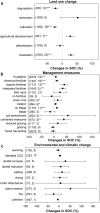Changing soil carbon: influencing factors, sequestration strategy and research direction
- PMID: 32067129
- PMCID: PMC7227295
- DOI: 10.1186/s13021-020-0137-5
Changing soil carbon: influencing factors, sequestration strategy and research direction
Abstract
Soil carbon (C) plays a critical role in the global C cycle and has a profound effect on climate change. To obtain an in-depth and comprehensive understanding of global soil C changes and better manage soil C, all meta-analysis results published during 2001-2019 relative to soil C were collected and synthesized. The effects of 33 influencing factors on soil C were analyzed, compared and classified into 5 grades according to their effects on soil C. The effects of different categories of influencing factors, including land use change (LUC), management and climate change, on soil C and the underlying mechanism were compared and discussed. We propose that natural ecosystems have the capacity to buffer soil C changes and that increasing C inputs is one of the best measures to sequester C. Furthermore, a comparison between the meta-analyses and previous studies related to soil C based on bibliometric analysis suggested that studies on wetland soil C, soil C budgets and the effects of pollution and pesticides on soil C should be strengthened in future research.
Keywords: Agricultural management; Carbon budgets; Climate change; Human activities; Land use change; Meta-analysis; Soil carbon; Wetland.
Conflict of interest statement
The authors declare that they have no competing interests.
Figures



References
-
- Batjes NH. Total carbon and nitrogen in the soils of the world. Eur J Soil Sci. 2014;65:10–21. doi: 10.1111/ejss.12114_2. - DOI
-
- Edenhofer O, Pichs-Madruga R, Sokona Y, Farahani E, Kadner S, Seyboth K, Adler A, Baum I, Brunner S, Eickemeier P, Kriemann B, Savolainen J, Schlömer S, Stechow CV, Zwickel T, Minx JC, editors. Climate change 2014: Mitigation of climate change. Contribution of Working Group III to the Fifth Assessment Report of the Intergovernmental Panel on Climate Change. Cambridge, United Kingdom and New York, NY, USA.: Cambridge University Press; 2014.
-
- Franko U, Ruehlmann J. SOC sequestration as affected by historic and present management. Geoderma. 2018;321:15–21. doi: 10.1016/j.geoderma.2018.02.006. - DOI
Publication types
Grants and funding
- 41807049/National Natural Science Foundation of China
- 41920104008/Natural Science Foundation of Jilin Province
- 41571255/Natural Science Foundation of Jilin Province
- 2016YFC0501202/National Key Research and Development Program of China
- KFZD-SW-112/Key Research Project of Chinese Academy of Sciences
- 2019SYHZ0039/Cooperative Project between CAS and Jilin Province of China
- 20190303070SF/Department of Science and Technology of Jilin Province
- 20180520090JH/Department of Science and Technology of Jilin Province
- 20180519002JH/Department of Science and Technology of Jilin Province
- 18DY019/Science and Technology Development Project of Changchun of China
LinkOut - more resources
Full Text Sources

